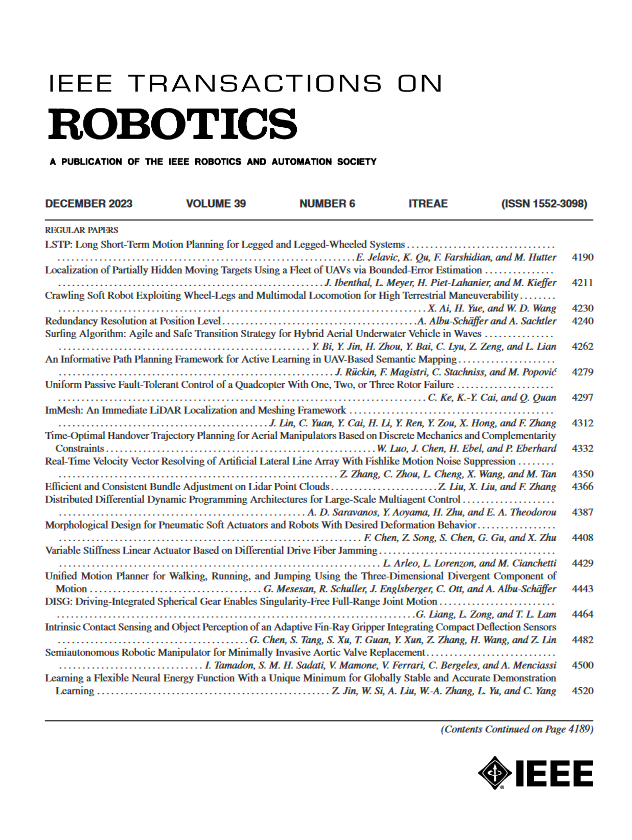领导还是跟随?人机协作中的自适应机器人任务规划
IF 10.5
1区 计算机科学
Q1 ROBOTICS
引用次数: 0
摘要
自适应任务规划是保证高效无缝人机协作的基础。本文介绍了一个机器人任务规划框架,该框架考虑了人类的领导/跟随偏好和性能,特别关注协作设置中的任务分配和调度。我们提出了一种具有三个主要目标的主动任务分配方法:1)提高团队绩效;2)结合人的偏好;3)维护人类对机器人和协作体验的积极感知。通过一项涉及自主移动机械手机器人与参与者一起在协作场景中工作的用户研究,我们确认任务规划框架成功地实现了所有三个预期目标,从而有助于推进人机协作中的自适应任务规划。本文主要关注前两个目标,我们将在后续文章中讨论第三个目标,即参与者对机器人、任务和协作的感知。本文章由计算机程序翻译,如有差异,请以英文原文为准。
To Lead or to Follow? Adaptive Robot Task Planning in Human–Robot Collaboration
Adaptive task planning is fundamental to ensuring effective and seamless human–robot collaboration. This article introduces a robot task planning framework that takes into account both human leading/following preferences and performance, specifically focusing on task allocation and scheduling in collaborative settings. We present a proactive task allocation approach with three primary objectives: 1) enhancing team performance; 2) incorporating human preferences; and 3) upholding a positive human perception of the robot and the collaborative experience. Through a user study, involving an autonomous mobile manipulator robot working alongside participants in a collaborative scenario, we confirm that the task planning framework successfully attains all three intended goals, thereby contributing to the advancement of adaptive task planning in human–robot collaboration. This article mainly focuses on the first two objectives, and we discuss the third objective, participants’ perception of the robot, tasks, and collaboration in a companion article.
求助全文
通过发布文献求助,成功后即可免费获取论文全文。
去求助
来源期刊

IEEE Transactions on Robotics
工程技术-机器人学
CiteScore
14.90
自引率
5.10%
发文量
259
审稿时长
6.0 months
期刊介绍:
The IEEE Transactions on Robotics (T-RO) is dedicated to publishing fundamental papers covering all facets of robotics, drawing on interdisciplinary approaches from computer science, control systems, electrical engineering, mathematics, mechanical engineering, and beyond. From industrial applications to service and personal assistants, surgical operations to space, underwater, and remote exploration, robots and intelligent machines play pivotal roles across various domains, including entertainment, safety, search and rescue, military applications, agriculture, and intelligent vehicles.
Special emphasis is placed on intelligent machines and systems designed for unstructured environments, where a significant portion of the environment remains unknown and beyond direct sensing or control.
 求助内容:
求助内容: 应助结果提醒方式:
应助结果提醒方式:


